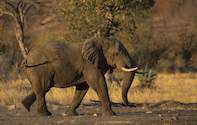
Elephant tail hairs and satellite tracking collars are being linked up to help find out where best to establish sanctuaries to protect elephants. In research published in the Proceedings of the National Academy of Sciences, both the tail hairs and global positioning system (GPS) coordinates reveal how elephants in Kenya move about in search of food, and what foods they favour at different times of the year.
The longest possible tail hairs were collected from elephants when they were fitted with the GPS collars and when the batteries in the collars were replaced. The hairs were then analysed for stable isotopes. Isotopes are different weights or types of elements, in this case carbon and nitrogen, which occur naturally.
Because grass and trees take up carbon by different mechanisms when they photosynthesise, they have different ratios of carbon-12 and carbon-13. Scientists can get an idea of the climate in which the plants were growing by looking at the ratio of nitrogen-15 to nitrogen-14.
Wetter areas, like the forests on Mount Kenya, have lower ratios of nitrogen-15 to nitrogen-14, while dry areas like Samburu have high ratios. As the elephant's diet changes, so does the ratio of the carbon and nitrogen isotopes in its body, teeth, tusks and tail hairs as the compounds from the plants are incorporated into the growing animal. The longer the tail hair, the longer the record of what the elephant has been eating.
The tusks of the 'magnificent seven' big tuskers in the Letaba Elephant Museum were drilled by scientists some time ago to search for similar isotopic clues to their diet over the years. For seven elephants tracked from 2000 to July 2002 in the Kenyan study, the discovery was made that they spent most of their time in the arid lowlands of Samburu eating trees and shrubs. During the wet season the ratio of carbon-13 to carbon-12 switched to show that they ate the grasses that began to grow with the rains.
One bull elephant only spent the rainy time of the year eating grass in the Samburu lowlands, but regularly trekked the 40 kilometres to the Imenti Forest on Mount Kenya. While in the forest he repeatedly raided the nearby villagers' maize crop, elevating his carbon isotope ratio above that expected if he were only eating the shrubs and trees in the forest.
The elephant's crop raiding habits led to his suffering multiple gunshot wounds and eventually dying. One of the authors of the study, Iain Douglas-Hamilton, said that the study shows that "tracking stable isotopes in an elephant's diet - when combined with actual tracking of movements using high-tech remote sensing - provides a powerful new tool for conservationists. It allows us to understand possible elephant motivation and, from this, to see how management plans can be focussed on understanding their basic needs for space."

 The African Elephant is the world's largest land mammal, and weighs up to 7 tonnes and reaches heights of 3.3 m at the shoulder. Where are E...
The African Elephant is the world's largest land mammal, and weighs up to 7 tonnes and reaches heights of 3.3 m at the shoulder. Where are E...